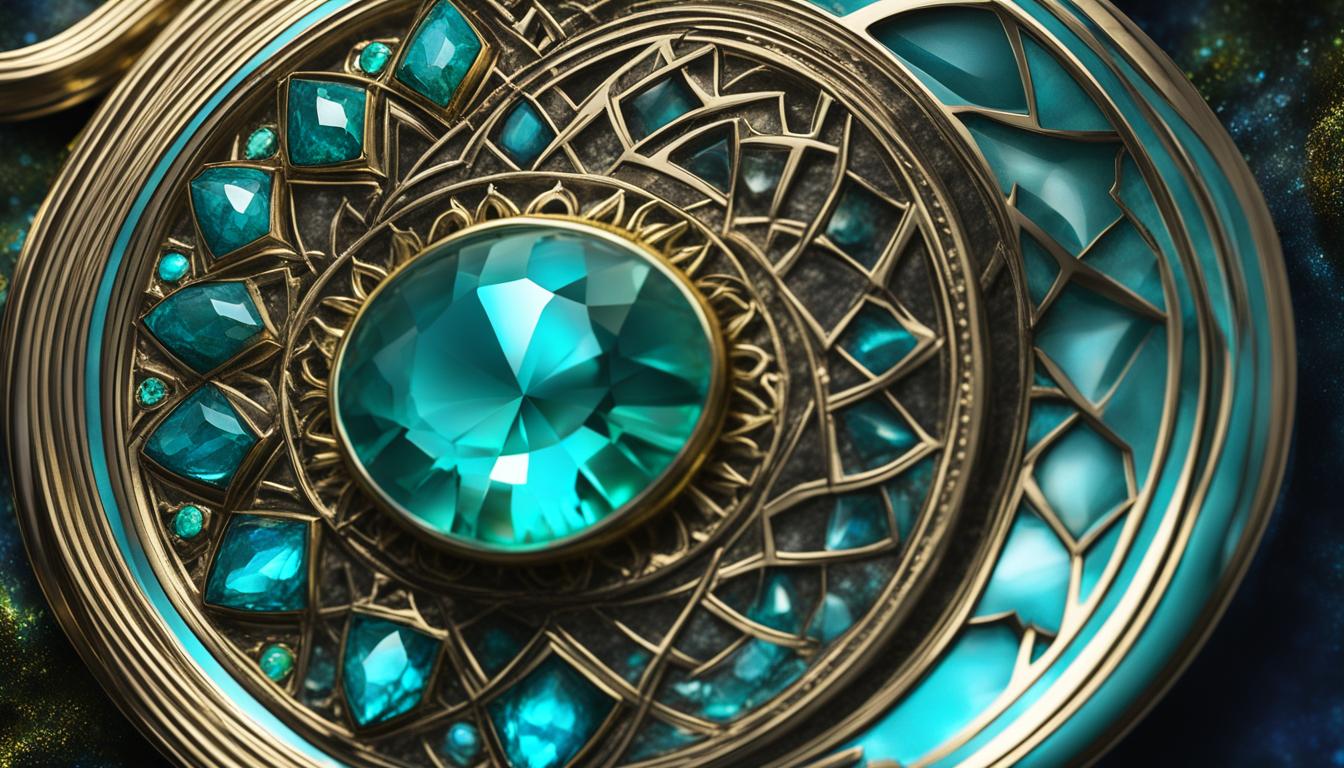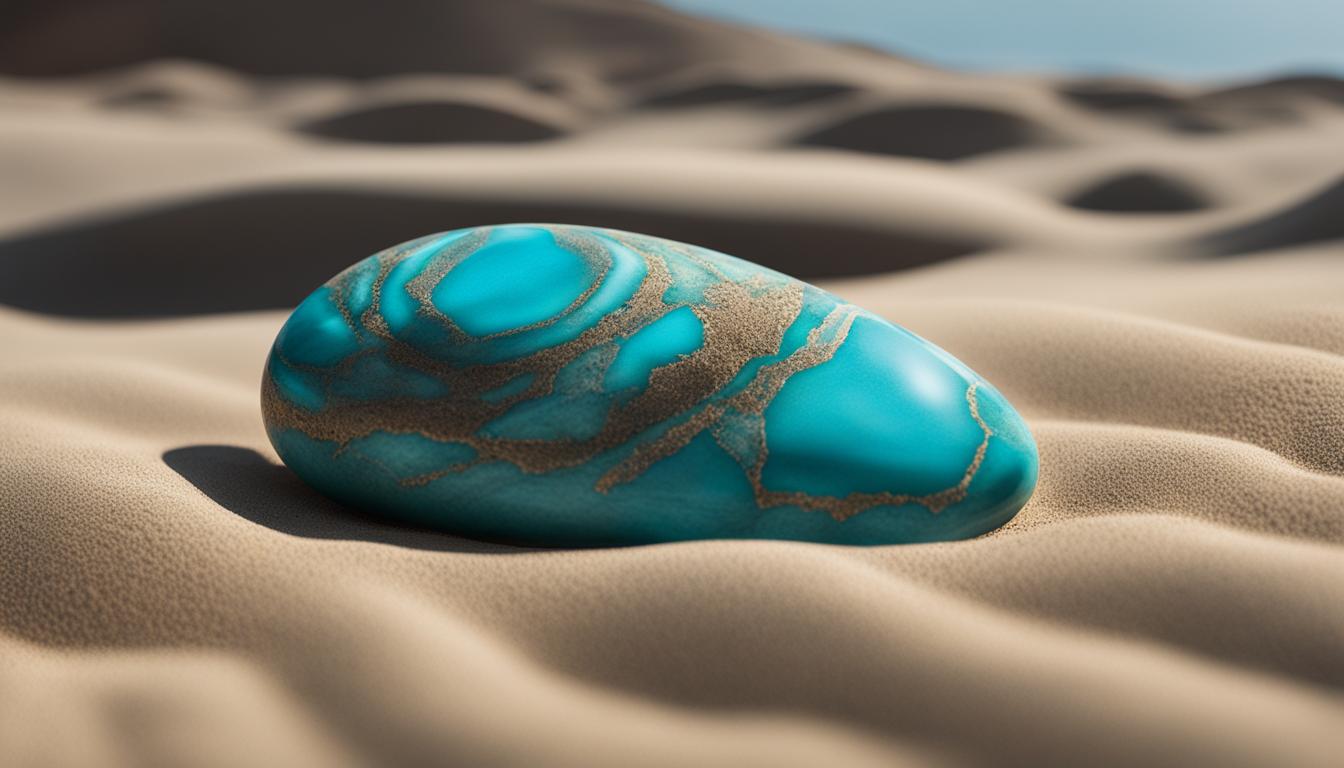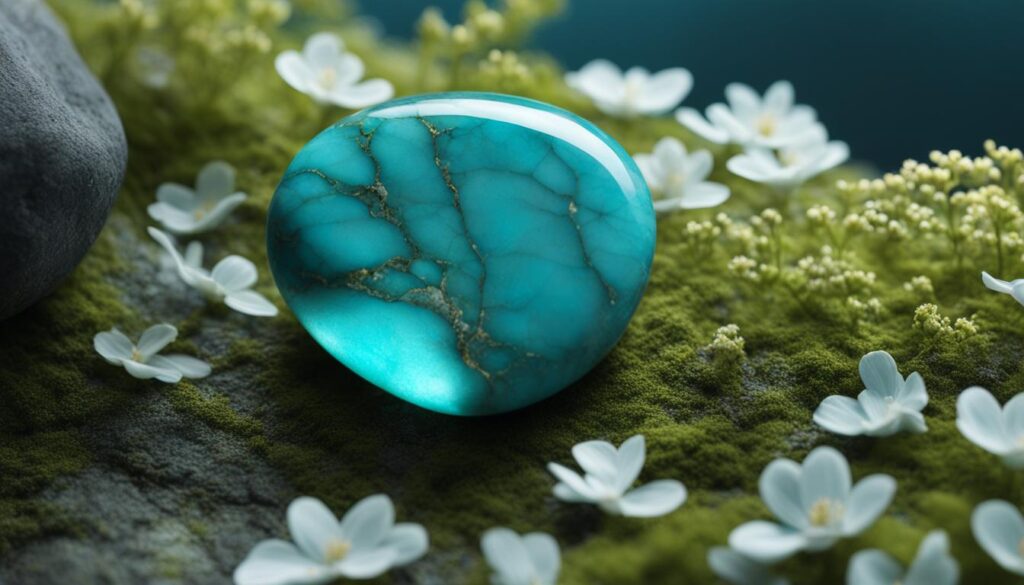Turquoise, with its captivating beauty, has intrigued humanity for centuries. This gemstone holds not just aesthetic appeal but also carries profound symbolism, spiritual meaning, and healing properties. Are you curious about the mysteries behind turquoise? Let’s dive in and explore the origins, attributes, and significance of this extraordinary gem.
Key Takeaways:
- Discover the spiritual and symbolic meanings associated with turquoise.
- Explore the healing properties of turquoise and its metaphysical significance.
- Uncover the diverse color variations and origins of turquoise.
- Learn how to identify genuine turquoise and care for this precious gemstone.
- Gain insights into the history, attributes, and value of turquoise.
A Brief Overview of the Turquoise Gemstone
Turquoise is a fascinating gemstone with a rich history that spans centuries. Renowned for its striking blue and green hues, turquoise holds a special place in the world of gemstones. Whether used in religious ceremonies, as a symbol of wealth and status, or in art and jewelry, turquoise has always been cherished for its unique attributes.
One of the key factors that determine the value of turquoise is its color. From sky blue to deep green, the spectrum of turquoise hues is truly mesmerizing. The presence of copper and iron within the stone contributes to its distinct color variations. Additionally, matrix patterns, the intricate lines and designs formed by the host rock, further enhance the beauty and value of turquoise.
The history of turquoise is as fascinating as its appearance. This gemstone has been highly prized by cultures around the world. From ancient civilizations in Egypt, Persia, and China to Native American tribes in North America, turquoise has been revered for its spiritual and protective qualities. Its role in history and its enduring popularity in modern times make turquoise a gemstone of great significance and value.
Understanding the allure and significance of turquoise involves exploring its origins, historical use, physical attributes, and value. By delving into the world of turquoise, we can gain a deeper appreciation for this captivating gemstone and the role it plays in our lives.
The Symbolic Significance of Turquoise
Turquoise holds profound symbolic meaning in various cultures. It represents purity, healing, and protection, and is believed to bridge the gap between the physical and spiritual realms. In Native American culture, turquoise is associated with wisdom, tranquility, protection, good fortune, and hope. It is also seen as a conduit for spiritual communication and a reflection of the divine.
The spiritual meaning of turquoise can be traced back to ancient times. It has long been revered as a sacred stone with powerful metaphysical properties. Turquoise is believed to enhance spiritual growth, intuition, and psychic abilities. Its calming energy is said to promote inner peace and serenity, helping individuals connect with their higher selves and tap into their spiritual wisdom.
Turquoise is a stone of protection and has been used for centuries to ward off negative energy and evil spirits. It is believed to create a shield of positive energy around the wearer, keeping them safe from harm. Turquoise also helps to purify and cleanse the energy of the surrounding environment, promoting a sense of peace and harmony.
In Native American culture, turquoise holds a special place in traditional ceremonies and rituals. It is often used in jewelry and adornments, not just for its aesthetic appeal, but also for its spiritual significance. Turquoise is believed to bring good fortune, attract positive energy, and promote spiritual healing. It is seen as a sacred stone that connects the physical and spiritual worlds, allowing for spiritual communication and guidance.
Table: Symbolism of Turquoise in Native American Culture
- Wisdom
- Tranquility
- Protection
- Good Fortune
- Hope
- Spiritual Communication
Whether worn as jewelry, used in meditation, or displayed in the home, turquoise is a powerful symbol of spirituality and protection. Its vibrant color and rich history make it an enduring gemstone that continues to captivate and inspire people around the world.
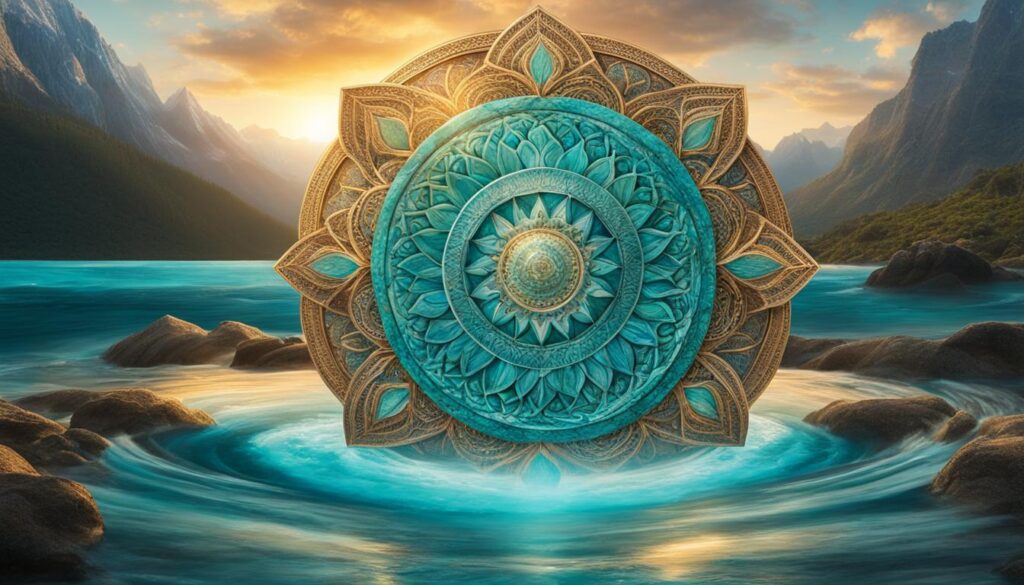
The Healing Properties of Turquoise
Turquoise is a remarkable gemstone that is believed to possess a myriad of healing properties. Its unique energetic vibration is said to have a positive impact on the mind, body, and spirit, making it a popular choice among those seeking holistic well-being.
One of the key spiritual properties of turquoise is its ability to enhance communication and intuition. It is believed to open the lines of communication between the physical and spiritual realms, promoting a deeper connection with one’s higher self and facilitating spiritual growth.
On an emotional level, turquoise is known for its calming and soothing effects. It is said to help relieve stress, anxiety, and depression, promoting a sense of inner peace and emotional balance. Additionally, turquoise is believed to enhance self-expression and encourage authenticity, allowing individuals to communicate their thoughts and feelings with clarity and confidence.
Turquoise Physical Properties:
- Strengthens the immune system
- Supports overall physical healing
- Alleviates pain and inflammation
- Boosts energy levels
“Turquoise has been prized for centuries for its protective and healing qualities. Its vibrant color is a visual reminder of its powerful energetic properties.”
When it comes to physical healing, turquoise is believed to have a range of benefits. It is said to strengthen the immune system, support overall physical healing, and alleviate pain and inflammation in the body. Additionally, turquoise is thought to boost energy levels and promote overall vitality.
Whether worn as jewelry, used in meditation, or placed in the home, turquoise is believed to bring a sense of balance, harmony, and well-being to its wearer or surroundings. Its healing properties have made it a popular choice for those seeking to align their mind, body, and spirit in pursuit of holistic wellness.
Understanding the Color Variations of Turquoise
Turquoise is a gemstone that displays a wide range of beautiful colors, making it truly unique and captivating. The color variations in turquoise are influenced by several factors, including the presence of copper and iron within the stone.
From vibrant greenish-blue tones to enchanting sky blue hues, each color variation of turquoise has its own beauty and charm. The greenish-blue shades have a higher copper content, while the sky blue shades contain more iron. This natural variation in color gives turquoise its distinctive look.
The origins of turquoise play a significant role in determining its color variations. Different locations around the world produce different types of turquoise, each with its own set of characteristics. Some of the most famous turquoise mines are located in the southwestern United States, Iran, and China. The turquoise from these regions varies in color and quality, adding to the allure of this gemstone.
When it comes to turquoise, the possibilities are endless. The color variations and origins of turquoise make it a fascinating gemstone that appeals to both collectors and jewelry enthusiasts. Whether you prefer the vibrant greenish-blue shades or the calming sky blue tones, turquoise is sure to make a statement wherever it goes.
Turquoise Origins and Types
- American Turquoise: Mined in states such as Arizona, Nevada, and New Mexico, American turquoise is known for its vibrant blue and green hues. It is highly valued for its quality and beauty.
- Persian Turquoise: Sourced from Iran, Persian turquoise is prized for its intense sky blue shade. It has been revered for centuries and is considered to be some of the finest turquoise in the world.
- Chinese Turquoise: China is known for producing turquoise in a range of colors, from deep blue to pale green. Chinese turquoise often features unique matrix patterns, adding to its visual appeal.
- Mexican Turquoise: Mexico is home to several turquoise deposits, and Mexican turquoise is cherished for its stunning colors and distinct matrix patterns.
Turquoise is a gemstone that embraces diversity in its color variations and origins. From the vibrant American turquoise to the prized Persian turquoise, each type of turquoise has its own story to tell.
Identifying Genuine Turquoise
When it comes to purchasing turquoise gemstones, it’s essential to be able to identify genuine turquoise. While there are many beautiful imitations on the market, nothing quite compares to the unique beauty and value of natural turquoise. Here are some key factors to consider:
- Color: Genuine turquoise comes in a variety of shades, ranging from sky blue to greenish-blue. Avoid stones that appear too bright or artificial in color.
- Matrix Patterns: Natural turquoise often features intricate matrix patterns caused by the presence of surrounding minerals. These patterns add character and uniqueness to the stone.
- Texture: Genuine turquoise has a smooth and waxy texture. Be wary of stones that feel rough or gritty to the touch, as they may be imitations or lower-quality turquoise.
To further ensure the authenticity of the turquoise you’re considering, it’s helpful to familiarize yourself with the turquoise grading system. This system takes into account factors such as color, clarity, hardness, and overall quality. It can provide valuable insights into the value and desirability of a particular turquoise gemstone.
“Genuine turquoise is a treasure to behold. Its natural beauty and unique characteristics make it highly sought after by collectors, jewelry enthusiasts, and those seeking its metaphysical properties.”
Why It Matters
Choosing genuine turquoise not only ensures that you’re investing in a valuable and authentic gemstone but also allows you to experience its true beauty and energetic properties. Natural turquoise has long been revered for its spiritual, healing, and protective qualities, making it a meaningful addition to any collection or piece of jewelry.
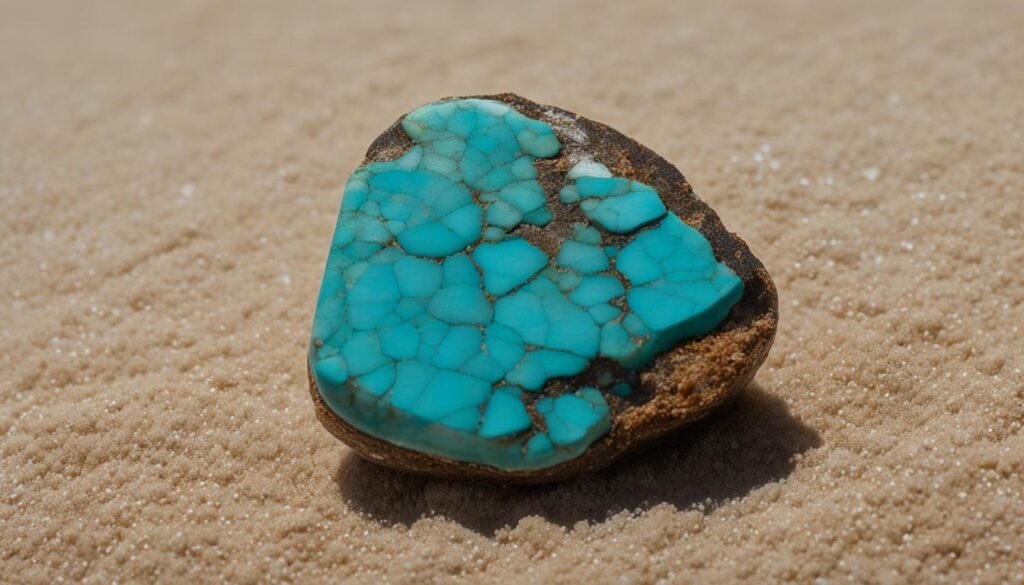
Caring for Turquoise Gemstone
Proper care and maintenance are essential to ensure the longevity and beauty of your turquoise gemstone. Follow these simple techniques to keep your turquoise looking vibrant:
1. Gentle Cleaning
Turquoise is a porous stone, so it is important to clean it gently using non-abrasive methods. Avoid using harsh chemicals, ultrasonic cleaning machines, and steam cleaners, as they can damage the stone. Instead, use a soft, damp cloth or a mild soap solution to gently wipe away any dirt or grime. Rinse thoroughly with water and pat dry with a soft cloth.
2. Avoid Exposure to Harsh Substances
Turquoise is sensitive to chemicals and substances that can cause discoloration or damage. Avoid exposing your turquoise gemstone to perfumes, lotions, household cleaners, and even natural oils. Remove your turquoise jewelry before applying any skincare or beauty products to prevent them from coming into contact with the stone.
3. Proper Storage
When not wearing your turquoise jewelry, store it in a separate compartment or a soft pouch to prevent scratching or damage. Keep it away from other gemstones and metals that may scratch the surface of the stone. Additionally, store your turquoise away from direct sunlight or extreme temperatures, as they can cause the color to fade or the stone to crack.
By following these simple care tips, you can ensure that your turquoise gemstone retains its natural beauty and remains a treasured piece for years to come.
FAQ
What does turquoise mean?
Turquoise symbolizes purity, healing, protection, wisdom, tranquility, and good fortune. It is also believed to bridge the gap between the physical and spiritual realms.
What are the healing properties of turquoise?
Turquoise is said to alleviate pain, support the immune system, promote emotional healing and balance, enhance intuition, and aid in spiritual growth.
What are the different color variations of turquoise?
Turquoise comes in a wide range of colors, from greenish-blue to sky blue. The color is influenced by the presence of copper and iron within the stone.
How can I identify genuine turquoise?
Genuine turquoise is rare and highly sought after. Factors such as color, matrix patterns, and whether the stone is natural or treated can help determine its authenticity.
How should I care for turquoise gemstones?
Turquoise should be cleaned gently using non-abrasive methods and should not be subjected to ultrasonic cleaning machines or steam cleaners. Proper storage is also important to prevent damage.
